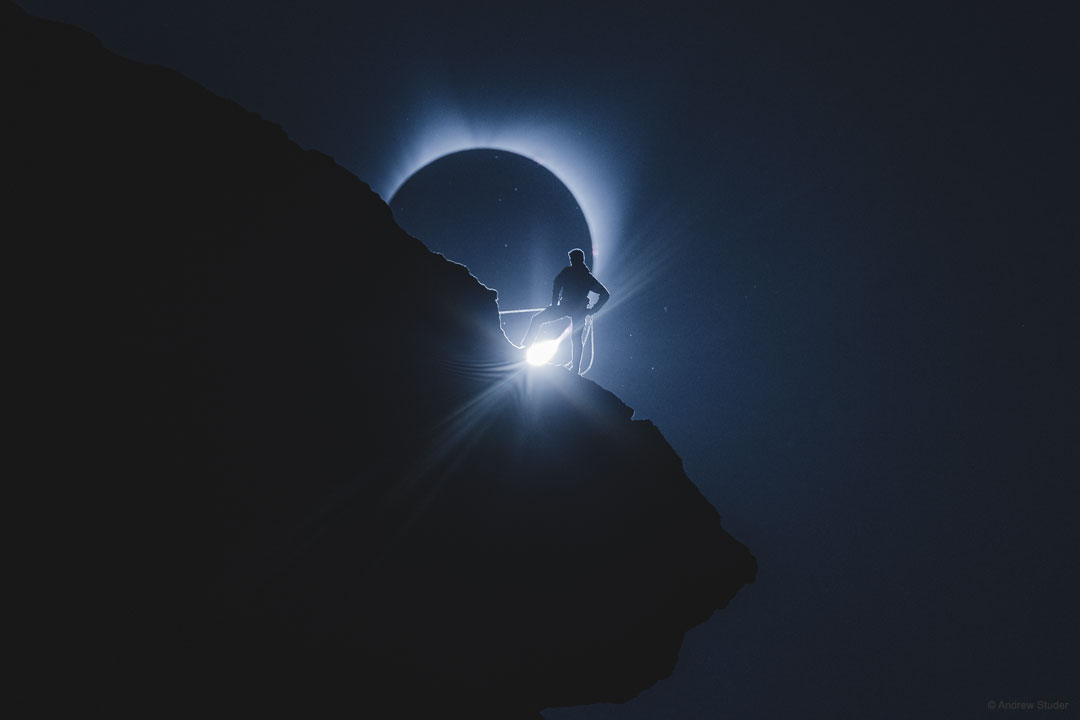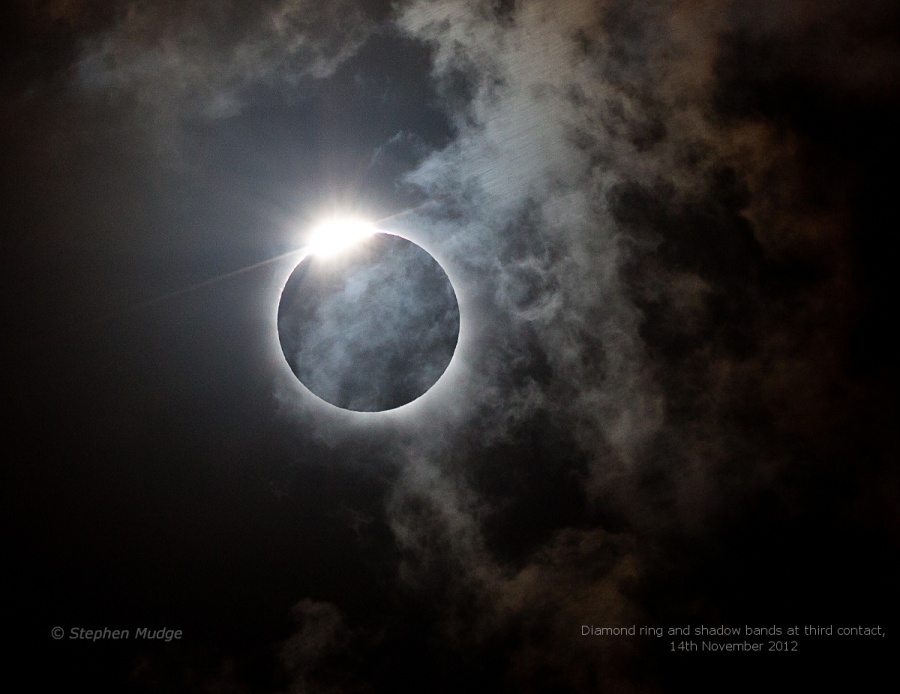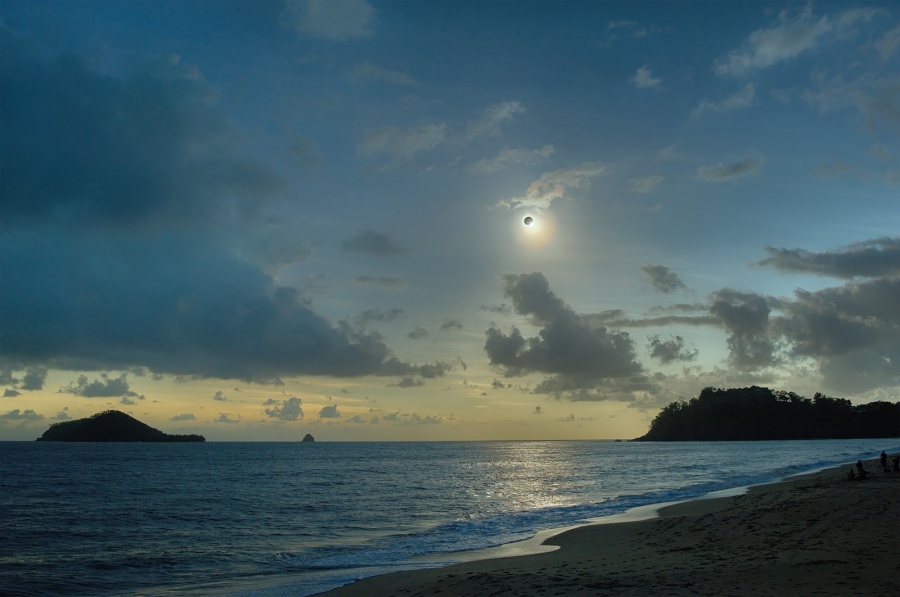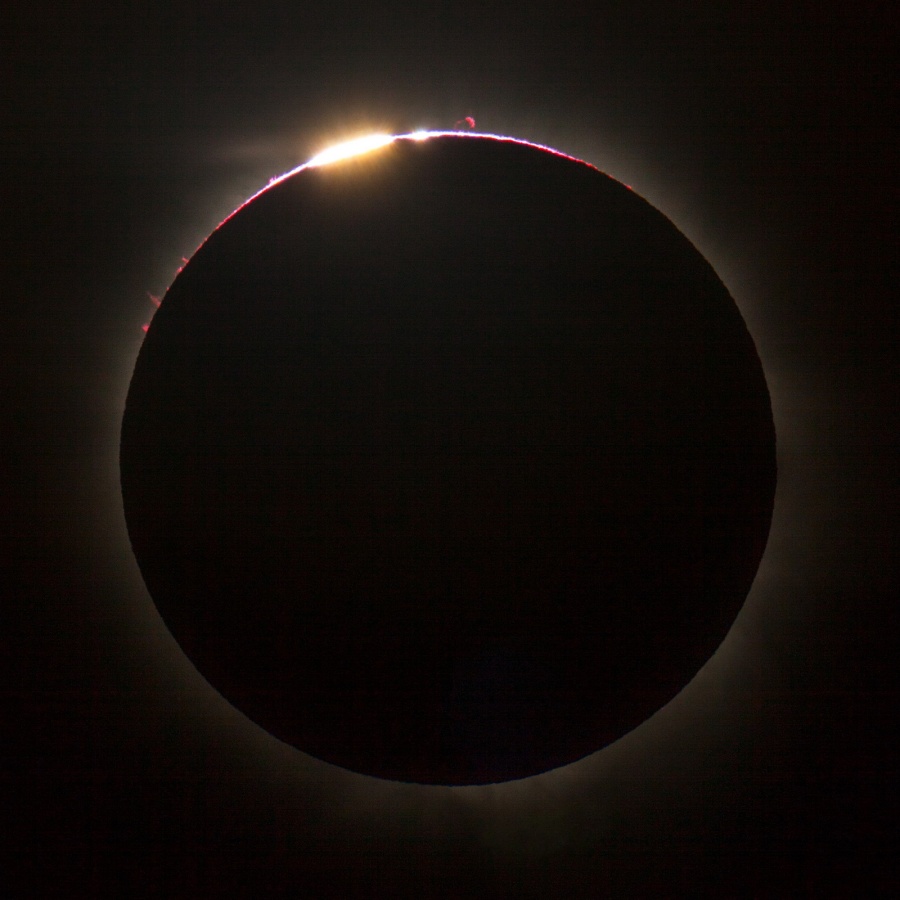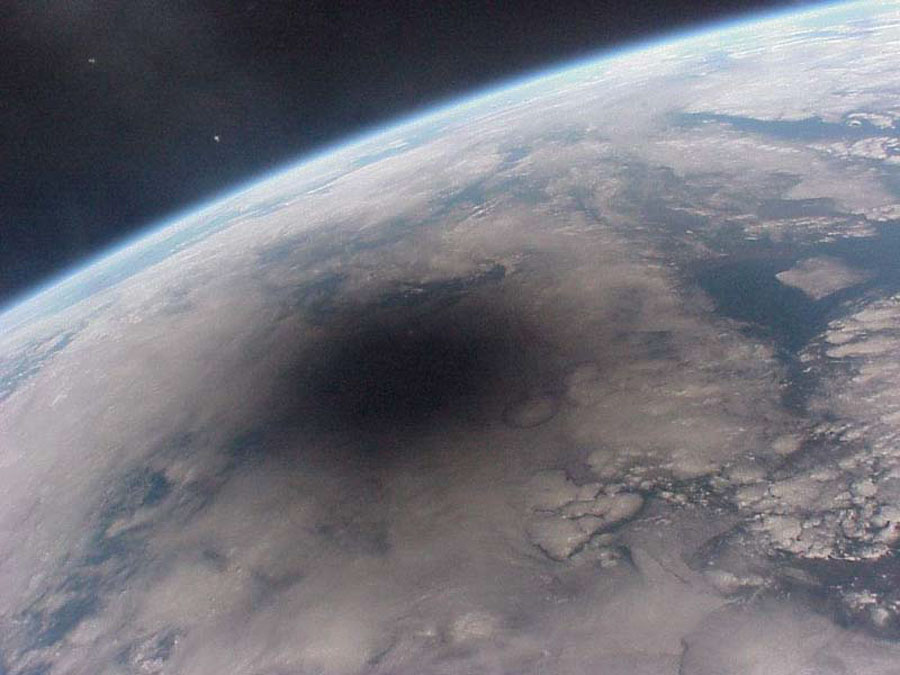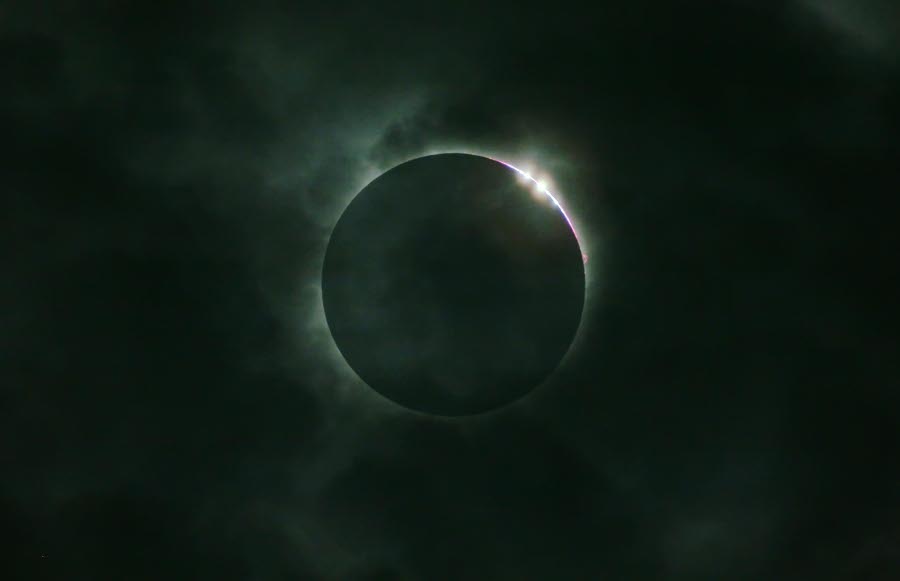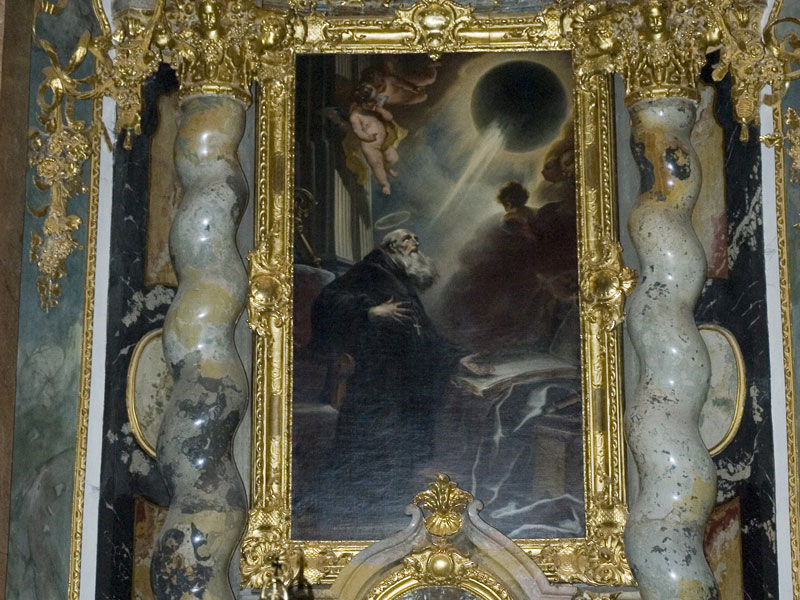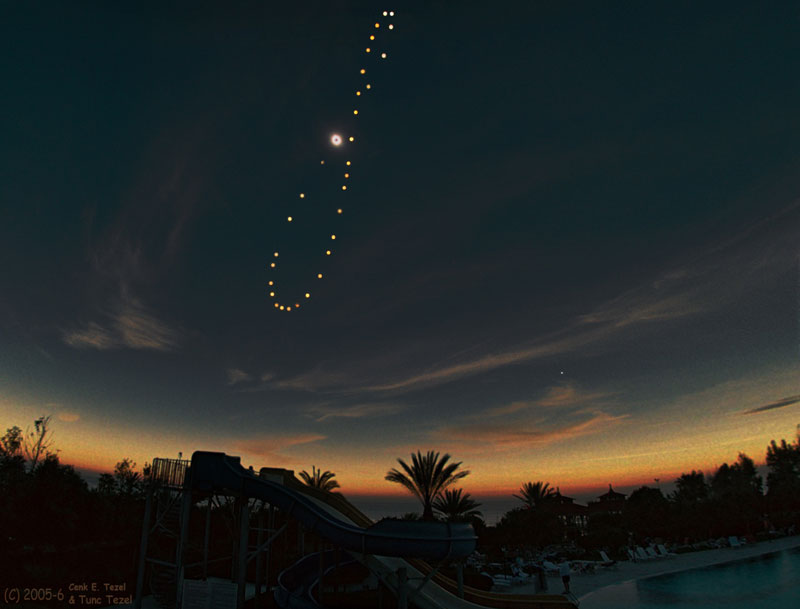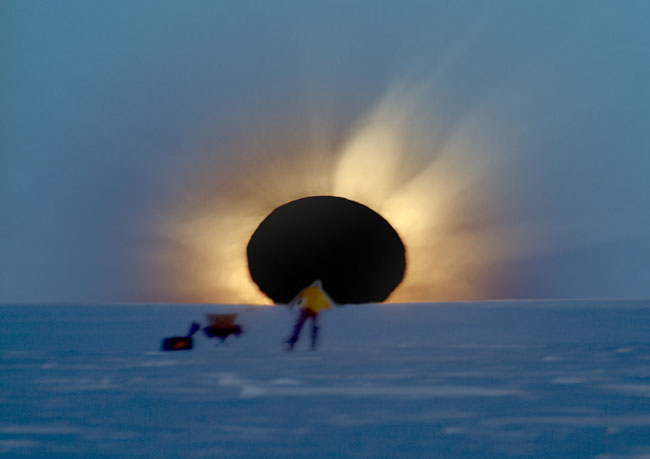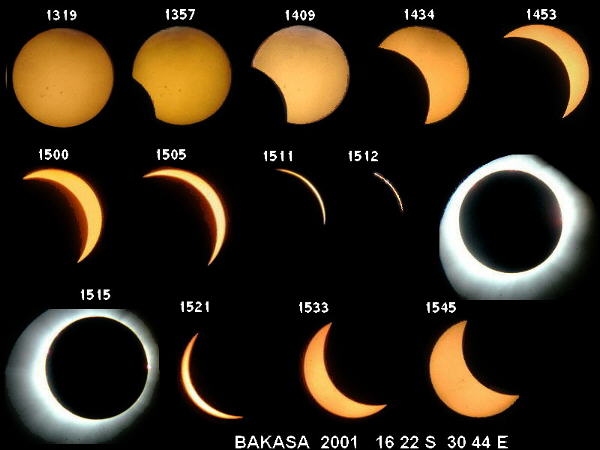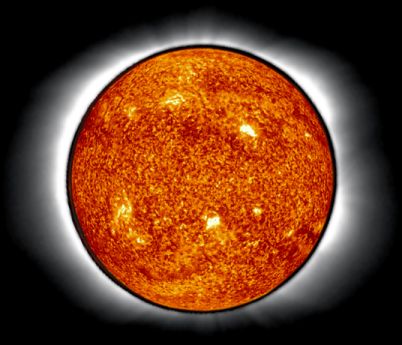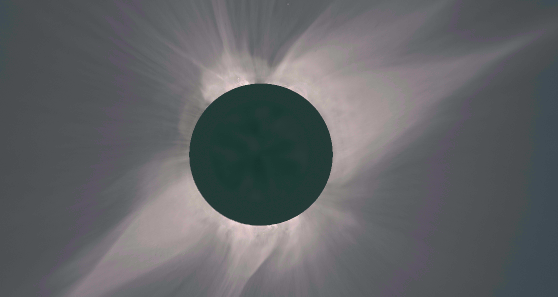APOD Collection: Total Solar Eclipses
APOD Collection: Total Solar Eclipses
Total Solar Eclipses
All titles are clickable and link to the original APOD page. Click on an image for a larger view of it.
2017 September 6 What should you do if your rock climbing picture is photobombed by a total eclipse of the Sun? Rejoice -- because your planning paid off. After months of considering different venues, and a week of scouting different locations in Oregon's Smith Rock State Park, a group of photographers and rock climbers led by Ted Hesser, Martina Tibell, and Michael Shainblum settled on picturesque 100-meter tall Monkey Face tower as the dramatic foreground for their images of the pending total solar eclipse. Tension mounted as the eclipse time approached, planned juxtapositions were scrutinized, and the placement of rock climber Tommy Smith was adjusted. Right on schedule, though, the Moon moved in front of the Sun, and Smith moved in front of the Moon, just as planned. The solar eclipse image displayed here actually shows a diamond ring, an eclipse phase when a bit of the distant Sun is still visible beyond the Moon's surface.
2014 April 7 Has a solar eclipse ever been seen from the Moon? Yes, first in 1967 -- but it may happen again next week. The robotic Surveyor 3 mission took thousands of wide angle television images of the Earth in 1967, a few of which captured the Earth moving in front of the Sun. Several of these images have been retrieved from the NASA archives and compiled into the above time-lapse video. Although the images are grainy, the Earth's atmosphere clearly refracted sunlight around it and showed a beading effect when some paths were blocked by clouds. Two years later, in 1969, the Apollo 12 crew saw firsthand a different eclipse of the Sun by the Earth on the way back from the Moon. In 2009, Japan's robotic Kaguya spacecraft took higher resolution images of a similar eclipse while orbiting the Moon. Next week, however, China's Chang'e 3 mission, including its Yutu rover, might witness a new total eclipse of the Sun by the Earth from surface of the Moon. Simultaneously, from lunar orbit, NASA's LADEE mission might also capture the unusual April 15 event. Another angle of this same event will surely be visible to people on Earth -- a total lunar eclipse.
2012 December 14 On the morning of November 14, sky gazers from around the world gathered on this little planet to stand in the dark umbral shadow of the Moon. Of course, the Moon cast the shadow during last month's total solar eclipse, and the little planet is actually a beach on Green Island off the coast of Queensland, Australia. The picture itself, the first little planet projection of a total solar eclipse, is a digitally warped and stitched wrap-around of 8 images covering 360x180 degrees. To make it, the intrepid photographer had to remember to shoot both toward and away(!) from the eclipse during the excitement of totality. Near this little planet's horizon, the eclipsed Sun is just above center, surrounded by the glowing solar corona. Venus can be spotted in the shadow-darkened sky toward the top of the frame. At bottom right, bright star Sirius shines at the tip of an alarmingly tall tree.
2012 November 21 As the total phase of last week's solar eclipse came to an end, sunlight streaming past the edge of the Moon created the fleeting appearance of a glistening diamond ring in the sky. And while most eclipse watchers did not consider clouds a welcome sight, a view through thin clouds north of Cairns in Queensland, Australia also revealed these remarkable flickering shadow bands. Projected onto the cloud layer, the bands are parallel to the sliver of emerging sunlight. Caused by turbulence in Earth's atmosphere refracting the sliver of sunlight, the narrow bands were captured in this brief, 1/1000th second exposure.
2012 November 17 A dark Sun hung over Queensland, Australia on Wednesday morning during a much anticipated total solar eclipse. Storm clouds threatened to spoil the view along the northern coast, but minutes before totality the clouds parted. Streaming past the Moon's edge, the last direct rays of sunlight produced a gorgeous diamond ring effect in this scene from Ellis Beach between Cairns and Port Douglas. Winking out in a moment, the diamond didn't last forever though. The area was plunged into darkness for nearly 2 minutes as the Moon's shadow swept off shore toward Australia's Great Barrier Reef and out into the southern Pacific. Ranging from 1/4000 to 1/15 seconds long, five separate exposures were blended in the image to create a presentation similar to the breathtaking visual experience of the eclipse.
2012 November 15 This month's New Moon brought a total solar eclipse to parts of planet Earth on November 13 (UT). Most of the total eclipse track fell across the southern Pacific, but the Moon's dark umbral shadow began its journey in northern Australia on Wednesday morning, local time. From along the track, this telescopic snapshot captures the Moon's silhouette in skies over Queensland along the Mulligan highway west of Port Douglas. Almost completely covered, the Sun's disk is seen still surrounded by a hint of the faint solar corona. Planet-sized prominences stretch above the active Sun's edge. Sunlight streaming through gaps in the rugged profile of the lunar limb creates the brilliant but fleeting Baily's Beads.
2012 November 11 Just before the Sun blacks out, something strange occurs. As the Moon moves to completely cover the Sun in a total solar eclipse -- like the one set to occur over parts of Australia on Tuesday -- beads of bright sunlight stream around the edge of the Moon. This effect, known as Baily's beads, is named after Francis Baily who called attention to the phenomenon in 1836. Although, the number and brightness of Baily's beads used to be unpredictable, today the Moon is so well mapped that general features regarding Baily's beads are expected. When a single bead dominates, it is called the diamond ring effect, and is typically seen just before totality. Pictured above, horizontally compressed, a series of images recorded Baily's beads at times surrounding the 2008 total solar eclipse visible from Novosibirsk, Russia. At the end of totality, as the Sun again emerges from behind the moon, Baily's beads may again be visible -- but now on the other side of the Moon.
2011 January 2 Here is what the Earth looks like during a solar eclipse. The shadow of the Moon can be seen darkening part of Earth. This shadow moved across the Earth at nearly 2000 kilometers per hour. Only observers near the center of the dark circle see a total solar eclipse - others see a partial eclipse where only part of the Sun appears blocked by the Moon. This spectacular picture of the 1999 August 11 solar eclipse was one of the last ever taken from the Mir space station. The two bright spots that appear on the upper left are thought to be Jupiter and Saturn. Mir was deorbited in a controlled re-entry in 2001.
2010 August 4 Sometimes, during a total eclipse of the Sun, a strange shadow of darkness can be seen stretching off into the distance. Called shadow cones, they are visible because the Earth's atmosphere is not completely transparent, scattering sunlight and hence appearing blue during the day. Shadow cones are particularly dramatic for eclipses near the horizon, as geometry creates a long corridor of sun-blocked air. Visible above is a shadow cone caught during a sunset total solar eclipse visible last month from Patagonia, Argentina. The eclipsed Sun itself still appears bright around the edges of the Moon because of light from the surrounding corona. A few minutes later, the Moon began to move away from the Sun as both set behind distant Andes mountains.
2009 August 8 Cloudy skies over Wuhan, China hid the delicate solar corona during July's total eclipse of the Sun. Still, the Moon's silhouette was highlighted by these glistening diamonds as the total eclipse phase ended. Caused by bright sunlight streaming through dips and valleys in the irregular terrain along the Moon's edge, the effect is known as Baily's Beads, named after Francis Baily who called attention to the phenomenon in 1836. The dramatic appearance of the beads at the beginning or end of a total solar eclipse is also known as the Diamond Ring effect. In this remarkable image, a small, pinkish solar prominence can also be seen along the edge, below the diamonds.
2009 July 30 The July 22nd total solar eclipse was the longest of the 21st century. From the point of maximum eclipse along the Moon's shadow track across the Pacific Ocean, the Moon completely blocked the Sun for a total of 6 minutes and 39 seconds. But from the deck of this cruise ship the duration of the total eclipse phase was extended to a whopping 6 minutes and 42 seconds by the ship's motion along the shadow track. This panoramic view of the scene shows the shimmering solar corona in a darkened daytime sky, with clouds silhouetted by a bright sky on the distant horizon, beyond the Moon's shadow. Mercury can be seen near the eclipsed Sun. Venus lies near the upper right edge of the frame.
2009 July 26 Most photographs don't adequately portray the magnificence of the Sun's corona. Seeing the corona first-hand during a total solar eclipse is best. The human eye can adapt to see features and extent that photographic film usually cannot. Welcome, however, to the digital age. The above picture is a combination of thirty-three photographs that were digitally processed to highlight faint features of a total eclipse that occurred in March of 2006. The images of the Sun's corona were digitally altered to enhance dim, outlying waves and filaments. Shadow seekers need not fret, though, since as yet there is no way that digital image processing can mimic the fun involved in experiencing a total solar eclipse. Last week, a spectacular total solar eclipse occurred over southern Asia, while the The next total solar eclipse will be visible from the South Pacific on 2010 July 11.
2008 January 28 Is this painting the earliest realistic depiction of a total eclipse of the Sun? Some historians believe it is. The above painting was completed in 1735 by Cosmas Damian Asam, a painter and architect famous in early eighteenth century Germany. Clearly drawn is not only a total solar eclipse, but the solar corona and the diamond ring effect visible when sunlight flows only between mountains on the Moon. The person depicted viewing these eclipse phenomena is St. Benedict. Roberta J. M. Olson and Jay Pasachoff have hypothesized that Asam himself may have seen first hand one or all of the total solar eclipses of May 1706, 1724, and 1733. Many facts about our astronomical universe that are taken for granted today have been known -- or accurately recorded -- only during the last millennium. Asam's painting currently hangs in Weltenburg Abbey in Bavaria, Germany.
2007 October 2 If you went outside at exactly the same time every day and took a picture that included the Sun, how would the Sun appear to move? With great planning and effort, such a series of images can be taken. The figure-8 path the Sun follows over the course of a year is called an analemma. With even greater planning and effort, the series can include a total eclipse of the Sun as one of the images. Pictured is such a total solar eclipse analemma or Tutulemma - a term coined by the photographers based on the Turkish word for eclipse. The composite image sequence was recorded from Turkey starting in 2005. The base image for the sequence is from the total phase of a solar eclipse as viewed from Side, Turkey on 2006 March 29. Venus was also visible during totality, toward the lower right.
2005 May 6 April's spectacular geocentric celestial event was a rare hybrid eclipse of the Sun - a total or an annular eclipse could be seen depending on the observer's location. For Fred Espenak, aboard a gently swaying ship within the middle of the Moon's shadow track about 2,200 kilometers west of the Galapagos, the eclipse was total, the lunar silhouette exactly covering the bright solar disk for a few brief moments. His camera captured a picture of totality revealing the extensive solar corona and prominences rising above the Sun's edge. But for Stephan Heinsius, near the end of the shadow track at Penonome Airfield, Panama, the Moon's apparent size had shrunk enough to create an annular eclipse, showing a complete annulus of the Sun's bright disk as a dramatic ring of fire. Pictures from the two locations are compared above. How rare is such a hybrid eclipse? Calculations show that during the 21st century just 3.1% (7 out of 224) of solar eclipses are hybrid while hybrids comprise about 5% of all solar eclipses over the period 2000 BC to AD 4000.
2003 December 8 TThe Sun, the Moon, and two photographers all lined up last month in Antarctica during an unusual total eclipse of the Sun. Even given the extreme location, a group of enthusiastic eclipse chasers ventured near the bottom of the world to experience the surreal momentary disappearance of the Sun behind the Moon. One of the treasures collected was the above picture -- a composite of four separate images digitally combined to realistically simulate how the adaptive human eye saw the eclipse. As the image was taken, both the Moon and the Sun peaked together over an Antarctic ridge. In the sudden darkness, the magnificent corona of the Sun became visible around the Moon. Quite by accident, another photographer was caught in one of the images checking his video camera. Visible to his left are an equipment bag and a collapsible chair.
2001 July 6 Starting at the upper left, this sequence of images follows the progress of the magnificent 21 June, 2001 solar eclipse in the clear skies over Bakasa, Zimbabwe. These pictures were recorded using a small reflecting telescope and digital camera with the approximate local time given above each frame. A simple pair of "eclipse spectacles" were mounted as a filter in front of the telescope mirror and removed during totality. In the early and late phases of this eclipse of the active Sun, sunspot groups can be seen lingering on the solar surface. During eclipse totality, pinkish prominences are visible at the solar limb along with details of the normally hidden solar corona. Seen from this location, the total eclipse phase lasted just under 3 1/2 minutes as the Moon's shadow rushed across northern Zimbabwe at nearly 5,000 kilometers per hour.
1998 March 11 On February 26th, it was dark during the day. This total solar eclipse was the last visible from the Americas for this millennium. A total solar eclipse is exciting partly because it is so short. Were Earth's Moon farther away, no total eclipse would occur at all because the Moon would appear too small to block out all of the Sun. Were the Moon much closer to the Earth, the eclipse would last much longer. Oddly, the Sun and Moon have almost exactly the same angular size. Even for well located observers, this creates at most only a very few minutes of totality before the Moon's shadow moves away. During a total solar eclipse in 1919, these few minutes were long enough for scientists to determine that the Sun's gravity bends light from the stars behind it, dramatically confirming the accuracy of a new theory of gravity postulated over 80 years ago.
1998 February 27 Yesterday, the Moon's shadow reached out and touched the Earth, treating a large portion of the Western Hemisphere to an Eclipse of the Sun. This composite image combines pictures of the Sun made from both Earth and space. The central direct image of the solar surface was recorded yesterday by the Extreme Ultraviolet Imaging Telescope on board the space based SOHO observatory. It is surrounded by a telescopic picture of the Sun as seen from the island of Aruba during the total eclipse. The surrounding view of the eclipsed Sun reveals the gleaming solar corona, visible to ground based observers during totality. Such combined images can help connect explosive events and features on the Sun's surface with the corona and solar wind.
1995 October 24 Pictured above is a total solar eclipse, with the Sun's corona, clearly visible surrounding the Moon. This picture is a composite of differently exposed photos of an eclipse that occurred on July 11, 1991. Today there will be another total eclipse of the Sun, the last until March 1997. The path of today's total eclipse will begin in the Middle East, move though southern China, and end in the Pacific Ocean south of the Marshall Islands. Those only near the path will see a partial solar eclipse. NASA keeps detailed maps of the predicted path of the eclipse.
A closed mouth gathers no foot.
-
ed_turco
Re: APOD Collection: Total Solar Eclipses
You are the holder of the copyright for a picture of a Patagonian total solar eclipse. I would like to use a picture of yours as a part of a tribute to total eclipses. My tribute will be an overlay to the left of everything.
This is not for profit and not for any sort of publication other than sending a few friends a copy of the whole thing.
No one has ever paid me anything for what I have written, nor will they now.
Will you permit me to use your picture?
Thank you.
Ed Turco
This is not for profit and not for any sort of publication other than sending a few friends a copy of the whole thing.
No one has ever paid me anything for what I have written, nor will they now.
Will you permit me to use your picture?
Thank you.
Ed Turco
- geckzilla
- Ocular Digitator
- Posts: 9180
- Joined: Wed Sep 12, 2007 12:42 pm
- Location: Modesto, CA
- Contact:
Re: APOD Collection: Total Solar Eclipses
Ed, you will have to ask Daniel Fischer. See thr copyright line below the image.
Just call me "geck" because "zilla" is like a last name.
-
ed_turco
Re: APOD Collection: Total Solar Eclipses
geckzilla wrote:Ed, you will have to ask Daniel Fischer. See thr copyright line below the image.
All fine and dandy, but that does not give any idea as to where I can find this photographer.
Ed
- geckzilla
- Ocular Digitator
- Posts: 9180
- Joined: Wed Sep 12, 2007 12:42 pm
- Location: Modesto, CA
- Contact:
Re: APOD Collection: Total Solar Eclipses
Click through to the APOD itself and there is contact and website info if you follow the links.
Just call me "geck" because "zilla" is like a last name.
